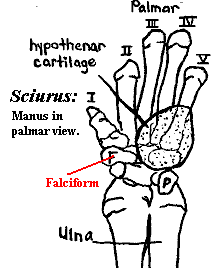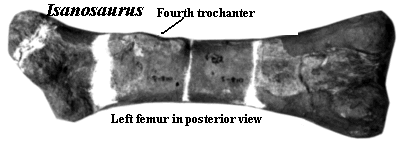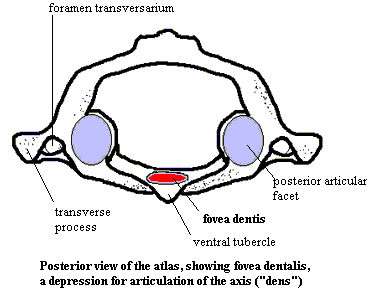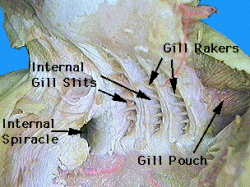
| Palaeos: |  |
Glossary |
| The Vertebrates | F-G |
| Page Back | Unit Back | Unit Home | Unit Dendrogram | Unit References | Glossary | Taxon Index |
| Page Next | Unit Next | Vertebrates Home | Vertebrate Dendrograms | Vertebrate References | Bones | Timescale |
For most phrases beginning with directional words, e.g. "posterior," "dorsal," "external," etc., or some generic anatomical terms, e.g., "vena," look under the next word in the phrase. However, note that this convention is not used with complete consistency in this Glossary.
Facet: any small articular surface, usually relatively flat.
Facial nerve: Cranial nerve VII. In fishes, this is the motor nerve associated with the hyoid gill arch. In tetrapods, it became associated with neck musculature. In mammaliforms it becomes the principal motor nerve controlling the facial muscles. Like the trigeminal (Vth) nerve, with which it closely associated, the facial nerve has several branches which may exit the brain separately. The principal branches are the superficial opthalmic, buccal, palatine & hyomandibular. However, all of these rami are present even in the hagfish, which has none of the structures these nerves normally innervate in mammals. Clearly, there has been quite a bit of re-engineering over the course of vertebrate evolution; and it is not possible to give a taxon-independent characterization of what the various branches accomplish.
 Falang
Fm.: Late Ladinian (Middle
Triassic) to Carnian (Late
Triassic) of
Guizhou Province, South China. The Falang Formation includes
the Zhuganpo, Wayao (= Xiaowa) and Laishike Members, which are often (usually?)
treated as separate formations. The Zhuganpo member includes extraordinary preservation of various
sauropterygian fossils (e.g.
Keichousaurus), as well as invertebrates (e.g. crinoids, brachiopods) from the latest Ladinian
(Post-Congress
Excursion and
Holmes et al., 2008)
or early Carnian (Lehrmann
et al., 2004).
Falang
Fm.: Late Ladinian (Middle
Triassic) to Carnian (Late
Triassic) of
Guizhou Province, South China. The Falang Formation includes
the Zhuganpo, Wayao (= Xiaowa) and Laishike Members, which are often (usually?)
treated as separate formations. The Zhuganpo member includes extraordinary preservation of various
sauropterygian fossils (e.g.
Keichousaurus), as well as invertebrates (e.g. crinoids, brachiopods) from the latest Ladinian
(Post-Congress
Excursion and
Holmes et al., 2008)
or early Carnian (Lehrmann
et al., 2004).
Falcate: same as falciform.
Falcate process: of the basioccipital. A sort of faux paroccipital process derived from the basioccipital and apparent mostly on the basicranium. Occurs in Remingtonocetus and other early whales.
 Falciform L. falx = sickle, and forma = form. The
falciform ligament has this shape. The falciform bone is an ossification of the falciform ligament at the base of the thumb (manus I).
Falciform L. falx = sickle, and forma = form. The
falciform ligament has this shape. The falciform bone is an ossification of the falciform ligament at the base of the thumb (manus I).
Famennian Age: Late Devonian. The last age of the Devonian Period, 364-354 Mya.
Fang pair: basal tetrapods frequently bore pairs of fangs on the inner row of bones in both the upper and lower jaw. In fact, these are not pairs of fangs, but rather a single fang and its replacement pit.
Fascia L. fascia = a ribbon or fillet.
Femoral: relating to the femur.
 Femur:
the upper leg bone. The femur articulates with the pelvis proximally and with
the tibia (and, usually, the fibula)
distally.
Femur:
the upper leg bone. The femur articulates with the pelvis proximally and with
the tibia (and, usually, the fibula)
distally.
Fenestra: L. = window. Generally opening in a structure, especially bone.
Fenestra cochleae: same as the fenestra rotunda.
Fenestra exonaria: the external nares, the "nostril." Thus, the anterior nares in non-choanates is the fenestra exonaria anterior.
Fenestra ovalis: the oval window in the inner ear which communicates with the stapes or columella, and with the operculum if present. See The Ear.
Fenestra pseudorotunda: a structure in reptiles functionally analogous to the fenestra rotunda of mammals, i.e. the distal end of the perilymphatic duct and lateral opening of the recessus scala tympani, where the remaining energy of a compression wave in the inner ear is dissipated. Fortunately -- for just such questions -- we also have a small essay on the inner ear in reptiles. The fenestra pseudorotunda is created by walling off part of the metotic foramen into a specialized vagus foramen for the exit of various cranial nerves.
Fenestra rotunda: the round window in the inner ear which relieves pressure in the inner ear. See The Ear.
Fenestra vestibulae: same as fenestra ovalis.
Fermentation: digestion; the oxidation of carbohydrates to water, carbon dioxide and simple organics with the net production of ATP (adenosine-5'-triphosphate).
Fibrocartilage: cartilage containing collagen fibers; found in the intervertebral disks and pubic symphysis. Introduction to the skeletal system.
Fibula: the smaller and more lateral of the two lower leg bones.
Fibulare: the calcaneum of mammals.
Fish's Law: a "law" of evolution we have taken the liberty of naming for the work of Prof. Frank Fish (1998). We have devised the following useful mnemonic to assist in remembering the rule:
The style of locomotion lags the
locus of the motion
So the motor muscle sequence is the same on land or ocean.
In other words, locomotion is conservative. Lifestyle, and even body form, tend to evolve faster than the basic hard-wired locomotor patterns.
Fissura Glaseri: same as petrotympanic fissure
fl. (abbrev.) floriat. Indicates the period of greatest success and diversity for a taxon.
Fleming Fjord formation: Late Triassic of Greenland. Dinosaurs, early mammaliforms. Sites: Tait Berg Beds (Rhaetian).
Flexor bone: an ossified flexor tendon serving as a third element of the distal limb (zeugopodium). See image at Chrysochloroidea.
Flexor muscles: the muscles which flex the digits of the fore- or hindlimb in tetrapods.
Floian Age: second age of the Early Ordovician, 479-472 Mya. See Floian.
Fluorapatite: a mineral found, inter alia, in the highly mineralized cap of shark's teeth. See apatite for an explanation of this remarkable class of minerals. Fluorapatite is slightly harder than hydroxyapatite, the more usual mineral component of bone, and less easily attacked by biochemical agents. In fact, the whole point of fluoridating public water supplies is to substitute fluoride ions for hydroxyl ions on the surface layer of human teeth in order to improve resistance to bacterial tooth decay.
Follicle L. folliculus, diminutive of follis = a bag.
Fontanel (fontanelle): an opening (usually medial) in the skull. As far as I can tell, there is no formal difference between fenestra, foramen and fontanels. "Foramen" is usually used when something (e.g. nerve, vessel, notochord) normally passes through the opening in life. "Fenestra" is usually used for paired openings. "Fontanel" is infrequently used and generally refers to an unpaired, mid-line opening.
Foramen L. foramen = an opening; from forare = to bore.
Foramen magnum: the "big hole" in the occiput through which the spinal nerves enter the brain. See The Braincase and The Occiput for details.
Foramen ovale: see fenestra ovalis.
Foramen pseudorotundum: in spite of the name, it has nothing really to do with the ear. This is a foramen in the anterior lamina of the petrosal by which the maxillary branch of the trigeminal nerve (V) exits the braincase. But see fenestra pseudorotunda, supra.
Foramen pseudovale: as with the f. pseudorotundum, this is unrelated to hearing. It is a foramen in the anterior lamina of the petrosal by which the mandibular branch of the trigeminal nerve (V) exits the braincase.
Fort Union Formation: Paleocene terrestrial? of Wyoming. Sites include the Gidley Quarry. Mammals.
Fossa L. fossa = a ditch. Used in anatomy for depressed areas.
Fossa antorbitalis maxillaris: same as antorbital fossa.
Fossa incudis: a region of the petrosal which is recessed to hold the incus.
Fossa trochanterica: a gap on the femoral head between the median tuberosity and the greater trochanter. See figure at femur.
Fossorial: burrowing habit, like moles, early snakes, etc.
Fourth tarsal: same as the cuboid for non-mammals.
 Fourth
trochanter: a muscle attachment point, which lies on the inside
surface of the femur in archosaurs. This is typically the attachment point of
the m. caudofemoralis which retracts the hind limb during the stance phase of
locomotion.
Fourth
trochanter: a muscle attachment point, which lies on the inside
surface of the femur in archosaurs. This is typically the attachment point of
the m. caudofemoralis which retracts the hind limb during the stance phase of
locomotion.
Fovea L. fovea = a pit. In ophthalmology it applies to the central depression in the retina (fovea centralis) associated with particularly acute vision.
 Fovea
dentis: a depression on the inner, ventral surface of the atlas for the
articulation of the axis ("dens"). See Image.
Fovea
dentis: a depression on the inner, ventral surface of the atlas for the
articulation of the axis ("dens"). See Image.
Fraenkelryggen Formation: from the Red Bay Group of Spitsbergen. Early Devonian (early to middle Lochkovian). Many jawless fishes including thelodonts, psammosteids, and heterostracans. Underlies the Ben Nevis Formation. Blom & Goujet (2002).
Francis Creek Shale: Late Carboniferous of Illinois, USA. Includes the famous Mazon Creek locations.
Frasnian Age: Late Devonian. The penultimate age of the Devonian Period, 377-367 Mya.
Friasian Age: South American Land Mammal Age corresponding to the Middle Miocene.
Frontal: One of the principal paired midline bones of the vertebrate skull. The frontals lie posterior to the nasals and anterior to the parietals, typically at the level of the orbits. In older (and some recent) papers on actinopterygian fishes, the term "frontal" refers to the parietal, due to a Nineteenth Century error in determining the homology of this bone. Although the error was pointed out by Westoll in 1943, many fish specialists have continued using the old terminology for the sake of consistency with the previous literature.
Frontate: of orbits, facing dorsally. Presumably so said because the line of vision then runs in the direction of the frontals. Many theropods, who are normally illustrated as looking down their snouts, might be better regarded as frontated so that their normal attitude would be with head down, looking over the bridge of the nose, so to speak.
Fulcral scales: or "Fringing fulcra." " ... special arrow-shaped scales ... on the leading edge of ... fins. Fringing fulcra are formed by fusion, side-by-side, of two adjacent elongated, diamond-shaped scales." Janvier (1996: 70).
Funnel pit: in most antiarch placoderms, a pit in dermal plate at the pectoral appendage ("arm") articulation containing the remaining scapulocoracoid structure. See image at axillary foramen.
Fusain: fossilized charcoal.
Galli, crista: see Crista galli.
Ganoid: a heavy form of enamel characteristic of the scales of various early fish and extant Polypteriformes.
Gashato Formation: Late Paleocene of Mongolia. Same as Khashaat Formation.
Gastric: relating to the stomach. Gastric fermentation is fermentation which occurs in the esophagus and stomach, as opposed to intestinal fermentation.
 Gastrocentrous:
a vertebral structure in which the neural spine rests on the pleurocentrum and
the intercentra are reduced to spacer elements appearing as arches over the
dorsal surface of the notochord between pleurocentra. See figure and note
under Anthracosauroidea.
Gastrocentrous:
a vertebral structure in which the neural spine rests on the pleurocentrum and
the intercentra are reduced to spacer elements appearing as arches over the
dorsal surface of the notochord between pleurocentra. See figure and note
under Anthracosauroidea.
Gastrocnemius: a large superficial muscle of the leg which originates on the femur and inserts on the heel (calcaneum) via the Achilles tendon and acts to extend the foot.
Gastrocoel: See Early Development Terms.
Gastrolith: a stone deliberately swallowed by an organism (usually a herbivore, or an herbivore if east of the Azores) and retained in the gut to cut and crush bulk food items. Many organisms exercise great selectivity in selecting gastroliths of the right size, shape and composition. When gastroliths are worn smooth, they are sometimes regurgitated. Presumably long-necked forms, like sauropods, got their rocks off in some other manner.
Gastrosteges: A single row of wide ventral scales in snakes which are erected during locomotion to increase friction.
Gastrulation: the process by which the blastula is invaginated to form a double-walled hollow sphere of cells in microlecithal development. Alternatively, the stage of embryonic development characterized by formation of a gastrula or its equivalent. The process is illustrated graphically in computer simulation. Conceptually, the blastula is a weakly inflated ball. Gastrulation is analogous to poking a finger into the ball at one point until the ball folds down around the finger. The cells surrounding the invaginated "finger" become the inner layer of a new double-walled sphere. The internal cavity thus formed is the archenteron. The entrance to the cavity, i.e. the base of the "finger," is the blastopore. The cell layer forming the outer wall is the epiblast and is generally fated to become ectoderm. The cell layer forming the inner wall is the hypoblast and is generally fated to become endoderm. Mesoderm forms in the former blastocoel, between the endodermal and ectodermal cell layers, particularly at the tip of the invaginating archenteron. In mesolecithal embryos, the case is similar. See Gastrulation II. See Atlas of Xenopus embryogenesis and subsequent figures. Mammalian gastrulation is similar to macrolecithal development. However, on this topic, I defer to Embryo Images Online - Unit 1 - Body Form. See also, Early Development Terms.
Gauja Formation: variously dated as Givetian or Frasnian of Latvia (probably Givetian). Reddish brown or -yellow sandstone and siltstone. Low energy fresh water environment. Various sarcopterygians and antiarch placoderms. Comparable fauna to Escuminac Formation, but with the addition of psammosteids. Vorobyeva (1980), Ahlberg et al. (2000); Forey et al. (2000).
Gedinnian: same as Lochkovian.
Geniculate: bent abruptly at an angle, normally a right angle. The reference is to L. genū = knee (closely related to Gr. κνήμη [cneme] = knee), as the bending of the leg at the knee (hence genuflect and similar words).
Ghost lineage: a phylogenetic lineage that is inferred to exist but has no fossil record. This sort of thing is one of the results -- and success stories -- of phylogenetic taxonomy, i.e. cladistics. For example, cladistic analysis demonstrated that birds must have derived from advanced theropods. Yet, the only advanced theropods were known from the Late Cretaceous, while Archaeopteryx -- clearly a bird -- was known from the Latest Jurassic. The necessary implication was that advanced theropods had been around for almost 70 My before the first known fossil evidence of their existence! This was far too much ectoplasmic ancestry for most of us to swallow even in the mid-1990's. But, with the products of the Great Chinese Feather Factory now before us, the gap is much smaller and there are few doubters left.
 Gill rakers: "one of a series of
variously shaped bony or cartilaginous projections on the inner side of the
branchial arch. The rakers have epithelial denticles and both their gross and
fine structure serves to retain food particles in the mouth. The gill raker
count normally includes all rakers, even the rudiments, and is made on the front
half of the first arch. Upper and lower gill raker counts may be presented as
the upper and the lower (including the central raker), e.g. 9 + 17; or as upper
rakers, central raker, and lower rakers, e.g. 9 + 1 + 16. The most anterior and
posterior rakers are often small and delicate, easily torn or lost if the arch
is removed. Plankton feeders have numerous, crowded, elongate and fine rakers
while predators have few, separated, short and stubby rakers." Dictionary of Ichthyology
(former site).
Fishes which eat large prey such as other fishes and mollusks have short, widely
spaced gill rakers. This type of gill raker prevents the prey item from escaping
between the gills. The gill rakers of the Blue Mackerel are like this. Fishes
which eat smaller prey have longer, thinner and more numerous gill rakers.
Species which feed on plankton and other tiny suspended matter have the longest,
thinnest and most numerous gill rakers, with some species having over 150 on the
lower arch alone. Fish Dissection - Gill rakers
Gill rakers: "one of a series of
variously shaped bony or cartilaginous projections on the inner side of the
branchial arch. The rakers have epithelial denticles and both their gross and
fine structure serves to retain food particles in the mouth. The gill raker
count normally includes all rakers, even the rudiments, and is made on the front
half of the first arch. Upper and lower gill raker counts may be presented as
the upper and the lower (including the central raker), e.g. 9 + 17; or as upper
rakers, central raker, and lower rakers, e.g. 9 + 1 + 16. The most anterior and
posterior rakers are often small and delicate, easily torn or lost if the arch
is removed. Plankton feeders have numerous, crowded, elongate and fine rakers
while predators have few, separated, short and stubby rakers." Dictionary of Ichthyology
(former site).
Fishes which eat large prey such as other fishes and mollusks have short, widely
spaced gill rakers. This type of gill raker prevents the prey item from escaping
between the gills. The gill rakers of the Blue Mackerel are like this. Fishes
which eat smaller prey have longer, thinner and more numerous gill rakers.
Species which feed on plankton and other tiny suspended matter have the longest,
thinnest and most numerous gill rakers, with some species having over 150 on the
lower arch alone. Fish Dissection - Gill rakers
Ginglymoid: of a joint, hinge-like.
Glauconite: A monoclinic mineral, 4[(K,Na)(Fe3+, Al, Mg)2 (Si, Al)4 O10 (OH)2 ] ; mica group; basal cleavage; dull, light to dark green; soft; a common authigenic mineral in marine sediments, useful for radiometric ages for host rocks. Sometimes called greensand. Cetacean remains are often associated with glauconitic sediments.
Glaserian fissure: same as petrotympanic fissure.
Glenoid (cavity): [1] the shallow cavity of the upper part of the scapula by which the humerus articulates with the pectoral girdle. [2] Also used to refer to the similar cavity in the squamosal (in mammals) or quadrate (in most other vertebrates) forming the jaw joint.
Glenoid fossa: same as glenoid, but almost always referring to the jaw joint.
Glove finger: in mysticete whales, a membrane which forms the inner part of the fibrous plug occluding the external auditory meatus. The glove finger is attached to the ectotympanic ring and the squamosal. Luo (1998).
Gluteal Gr. gloutos = buttocks
Gracile: slight, slender, small, light-weight, thin etc. Opposite of robust or massive. Gracile is best used to describe something which may be thinner and less massive than the object to which it may be compared, but retains a similar overall form and dimensions. Thus, a cheetah is more gracile than a tiger, but a house cat is just smaller.
Gravel: particles of rock or sediment more than 2 mm in diameter. See sand, silt, clay.
Greater trochanter: a trochanter located on the dorsolateral "corner" of the femoral head. See figures at femur and trochanter.
 Grebeshki:
a peculiar type of ornamentation found on the armor of heterostracans, sometimes
referred to as "oak-leaf shaped," for which no good English word
applies. Clearly, they don't look much like oak leaves -- perhaps more
like priapulid worms. For lack of reasonable alternatives, we adopt the
Russian term "гребешки" used by Novitskaya
(1986). Literally, this means "crista" or
"ridge". However, it is almost the same as the Russian word for
"scallop." Since these are, for a fact, scalloped ridges, the
term is doubly appropriate.
Grebeshki:
a peculiar type of ornamentation found on the armor of heterostracans, sometimes
referred to as "oak-leaf shaped," for which no good English word
applies. Clearly, they don't look much like oak leaves -- perhaps more
like priapulid worms. For lack of reasonable alternatives, we adopt the
Russian term "гребешки" used by Novitskaya
(1986). Literally, this means "crista" or
"ridge". However, it is almost the same as the Russian word for
"scallop." Since these are, for a fact, scalloped ridges, the
term is doubly appropriate.
Grès de Luxembourg: Jurassic of Luxembourg and Belgium. Marine bay.
Guettioua Formation: late Middle Jurassic (Bathonian - Callovian) of Morocco. Part of the Couches Rouge (Red Beds) of the Atlas Mountains. These are terrestrial exposures which overlie and interbed with marine carbonate facies. Monbaron et al. (1999). These authors state: "The environment suggested by the Guettioua formation is that of a vast plain close to sea level traversed by powerful rivers with anastomosing channels. The clastic load (principally pelites [lithified mudstone] and sand, with occasional stringers of pebbles) accumulated in the form of cross-bedded channel deposits."
Guild: Like a good many ecological terms, "guild" is intellectually interesting and productive, but almost impossible to define with any precision. If the ecological term "niche" can be compared to a species, the guild is a family. It consists of a group of similar niches which can be filled by organisms with the same general way of life, e.g., "large-bodied ambush hunters," "fossorial selective herbivores." There is a vague and much-contested correlation between adaptive radiations of organisms and ecological guilds, so the family-guild connection is not entirely specious (but speciose!). Thus, for example, in a moment of incautious speculation, these Notes speak of early dinosaurs moving into certain guilds. This makes a certain amount of theoretical sense, since the distance between niches in a guild is presumably large enough to maintain species stability, but small enough to permit adaptive radiation over reasonably short periods of geologic time. The word also carries the implication that there is substantial gap between guilds -- much larger than the gap between niches. If so, we ought perhaps to avoid describing guilds by reference to things like body size, which are continuous attributes of the organisms occupying the guild, rather than fairly sharp discontinuities in ecospace. However, this tradition is rather strong.
Guimarota: a coal mine in Portugal with a well-known Late Jurassic (Kimmeridgian) fauna, ~152 Mya.
Gulars: Bones lying between the two halves of the lower jaw in certain fishes. See The Gulars for a brief discussion and diagrams.
Gull River Formation: Middle Ordovician of Canada. Astraspidae, Thelodontida. Sansom & Elliott (2002).
| Page Back | Unit Home | Page Top | Page Next |
checked ATW050621